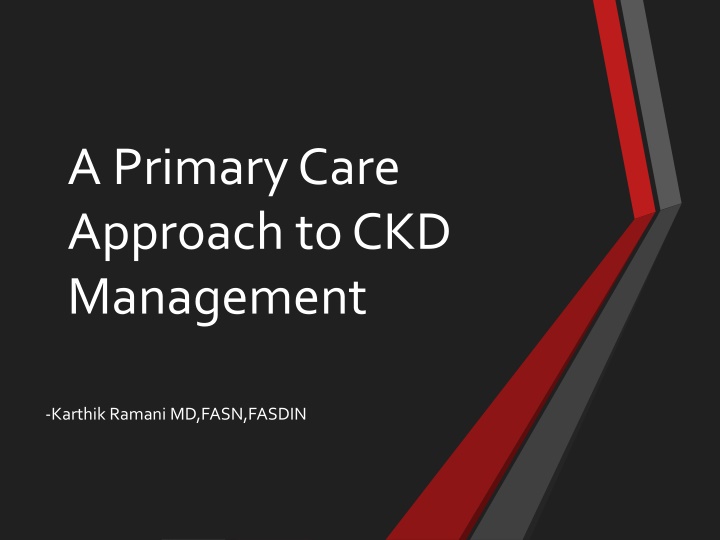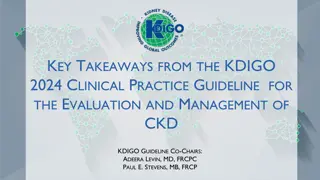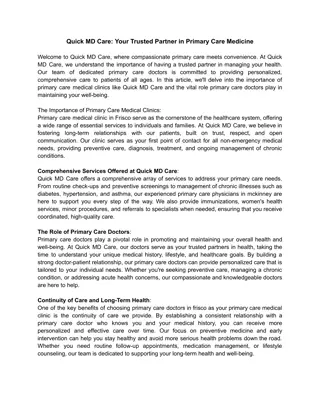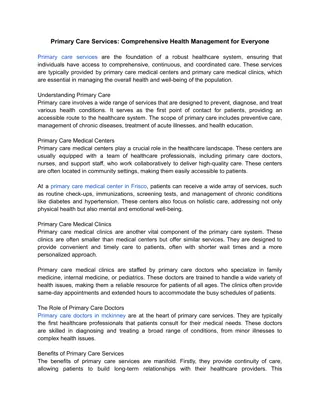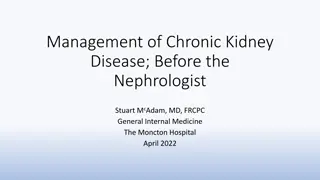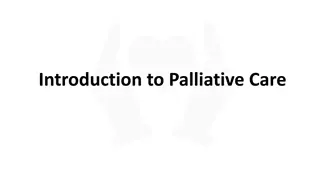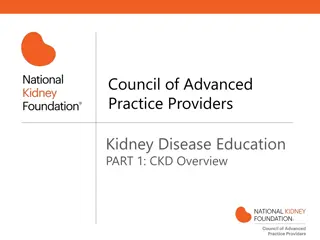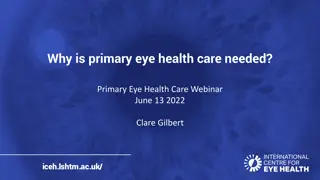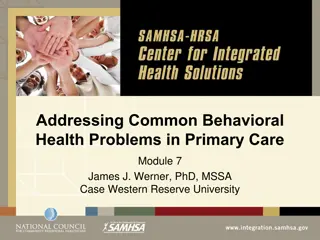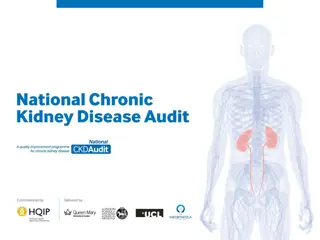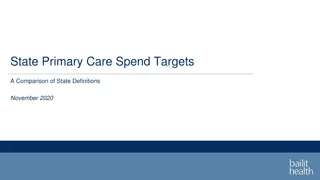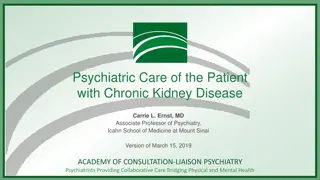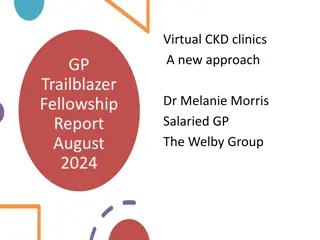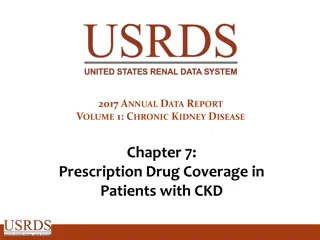Primary Care Approach to CKD Management
This informative presentation by Dr. Karthik Ramani emphasizes the crucial role of primary care providers in managing chronic kidney disease (CKD). It covers timely testing, intervention, and referral practices, along with case studies highlighting key considerations for patients with diabetes, hypertension, and CKD. By focusing on early detection and comprehensive management, primary care professionals can significantly impact patient outcomes and reduce the burden of CKD.
Download Presentation

Please find below an Image/Link to download the presentation.
The content on the website is provided AS IS for your information and personal use only. It may not be sold, licensed, or shared on other websites without obtaining consent from the author.If you encounter any issues during the download, it is possible that the publisher has removed the file from their server.
You are allowed to download the files provided on this website for personal or commercial use, subject to the condition that they are used lawfully. All files are the property of their respective owners.
The content on the website is provided AS IS for your information and personal use only. It may not be sold, licensed, or shared on other websites without obtaining consent from the author.
E N D
Presentation Transcript
A Primary Care Approach to CKD Management -Karthik Ramani MD,FASN,FASDIN
Disclosures None
Facilitate timely testing and intervention in patients at-risk for chronic kidney disease (CKD). Apply appropriate clinical measures to manage risk and increase patient safety in CKD. Learning Objectives Co-manage and refer patients to nephrology specialists, when appropriate, in order to improve outcomes in CKD.
Case Question 1 A 50-year-old Hispanic female was diagnosed with type 2 diabetes at age 30. She has taken medications as prescribed since diagnosis. The fact that she has confirmed diabetes puts this patient at: A. Higher risk for kidney failure and CVD B. Higher risk for kidney failure only C. Higher risk for CVD only D. None of the above
Case Question 2 A 55-year-old Caucasian-American man, with a history of type 2 diabetes (15 years), hypertension (3 years) dyslipidemia (5 years) and cardiovascular disease (myocardial infarction 3 years ago). He was recently diagnosed with CKD. His most recent labs reveal an eGFR of 45 ml/min/1.73m2 and an ACR of 38 mg/g. Which of the following should be avoided? A.ACE and ARB in combination B.Daily low-dose aspirin C.NSAIDs D.Statins E.A and C
Case Question 3 A 42-year-old African American man with diabetic nephropathy and hypertension has a stable eGFR of 25 mL/min/1.73m2. Observational Studies of Early as compared to Late Nephrology Referral have demonstrated which of the following? A. Reduced 1-year Mortality B. Increase in Mean Hospital Days C. No change in serum albumin at the initiation of dialysis or kidney transplantation D. Decrease in hematocrit at the initiation of dialysis or kidney transplantation E. Delayed referral for kidney transplantation
Primary Care Providers First Line of Defense Against CKD Primary care professionals can play a significant role in early diagnosis, treatment, and patient education A greater emphasis on detecting CKD, and managing it prior to referral, can improve patient outcomes CKD is Part of Primary Care
CKD as a Public Health Issue Increases risk for all- cause mortality, CV mortality, kidney failure (ESRD), and other adverse outcomes. 6 fold increase in mortality rate with DM + CKD Disproportionately affects African Americans and Hispanics
Offers opportunity to enhance kidney protective care by improving management of modifiable risk factors The Role of CKD Recognition in Population Health Improves prediction of incident cardiovascular events beyond traditional risk factors1 Encourages appropriate and timely referral to nephrology Early recognition of CKD: Can limit patient safety risk associated with CKD Matsushita, K., J. Coresh, et al. "Estimated glomerular filtration rate and albuminuria for prediction of cardiovascular outcomes: a collaborative meta- analysis of individual participant data." The Lancet Diabetes & Endocrinology 2015;3(7): 514-525.
Per person per month (PPPM) expenditures during the transition to ESRD, by dataset, 2011 Preventing progression of CKD will help hold down costs as the treatment of kidney failure is expensive. Incident Medicare (age 67 & older) & Truven Health MarketScan (younger than 65) ESRD patients, initiating in 2008. USRDS ADR, 2013
Gaps in CKD Diagnosis CKD Screening in Primary Care (% of patients) 60 50 40 Szczech, Lynda A, et al. "Primary Care Detection of Chronic Kidney Disease in Adults with Type-2 Diabetes: The ADD-CKD Study (Awareness, Detection and Drug Therapy in Type-2 Diabetes and Chronic Kidney Disease)." PLOS One - In press (2014). 30 20 10 0 Not Appropriately Tested Appropriately tested - no diagnosis Appropriately tested - accurate diagnosis % of Patients
Criteria for CKD Abnormalities of kidney structure or function, present for >3 months, with implications for health Either of the following must be present for >3 months: ACR >30 mg/g Markers of kidney damage (one or more*) GFR <60 mL/min/1.73 m2 *Markers of kidney damage can include nephrotic syndrome, nephritic syndrome, tubular syndromes, urinary tract symptoms, asymptomatic urinalysis abnormalities, asymptomatic radiologic abnormalities, hypertension due to kidney disease.m
Screening Tools: eGFR Considered the best overall index of kidney function. NormalGFR varies according to age, sex, and body size, and declines with age. The NKF recommends using MDRD and Cockroft Gault. GFR calculators are available online at www.kidney.org/GFR. Summary of the MDRD Study and CKD-EPI Estimating Equations: https://www.kidney.org/sites/default/files/docs/mdrd-study-and-ckd-epi-gfr-estimating-equations-summary-ta.pdf
Old Classification of CKD as Defined by Kidney Disease Outcomes Quality Initiative (KDOQI) Modified and Endorsed by KDIGO Stage Description Classification by Severity Classification by Treatment 1 Kidney damage with GFR 90 normal or increased GFR Kidney damage with 2 GFR of 60-89 T if kidney mild decrease in GFR transplant 3 Moderate decrease in GFR GFR of 30-59 recipient 4 Severe decrease in GFR GFR of 15-29 D if dialysis 5 Kidney failure GFR < 15 D if dialysis Note: GFR is given in mL/min/1.732 m KDIGO, Kidney Disease: Increasing Global Outcomes National Kidney Foundation. KDOQI Clinical Practice Guidelines for Chronic Kidney Disease: Evaluation, Classification, and Stratification. Am J Kidney Dis 2002;39(suppl 1):S1-S266
Classification of CKD Based on GFR and Albuminuria Categories: Heat Map Kidney Disease: Improving Global Outcomes (KDIGO) CKD Work Group. Kidney Int Suppls. 2013;3:1-150.
Improved Diagnosis Studies demonstrate that clinician behavior changes when CKD diagnosis improves. Significant improvements realized in:1-3 Increased urinary albumin testing Increased appropriate use of ACEi or ARB Avoidance of NSAIDs prescribing among patients with low eGFR Appropriate nephrology consultation 1. Wei L, et al. Kidney Int. 2013;84:174-178. 2. Chan M, et al. Am J Med. 2007:120;1063-1070. 3. Fink J, et al. Am J Kidney Dis. 2009,53:681-668.
CKD Risk Factors* Non-Modifiable Family history of kidney disease, diabetes, or hypertension Age 60 or older (GFR declines normally with age) Race/U.S. ethnic minority status Modifiable Diabetes Hypertension History of AKI Frequent NSAID use *Partial list AKI, acute kidney injury
Diabetes and hypertension are leading causes of kidney failure Incident ESRD rates, by primary diagnosis, adjusted for age, gender, & race. ESRD, end stage renal disease USRDS ADR, 2007
Does the patient have CKD? Assess GFR, albuminuria. Steps to CKD Patient Care Determine etiology. Assess for evidence of progression. Assess for associated complications. Patient education. Assess life expectancy and patient wishes for dialysis/transplantation.
DefinitionofChronicKidney Disease CKD is defined as abnormalities of kidney structure or function, present for >3 months, with implications for health. Kidney Disease: Improving Global Outcomes (KDIGO) CKD Work Group. Kidney Int Suppls. 2013;3:1-150.
Assign Albuminuria Category Albuminuria Categories in CKD ACR(mg/g) Terms Category <30 Normalto mildlyincreased A1 30-300 Moderately increased* A2 >300 Severely increased** A3 *Relative to young adult level. ACR 30-300 mg/g for >3 months indicates CKD. **Including nephrotic syndrome (albumin excretion ACR >2220 mg/g). Kidney Disease: Improving Global Outcomes (KDIGO) CKD Work Group. Kidney Int Suppls. 2013;3:1-150.
GFR Categories in CKD GFR Terms ClinicalPresentations Category 90 Normalorhigh Markersof kidney damage (nephrotic syndrome, nephritic syndrome, tubular syndromes, urinary tract symptoms, asymptomatic urinalysis abnormalities, asymptomatic radiologic abnormalities, hypertension due to kidney disease) G1 Assign GFR Category 60- 89 Mildlydecreased* G2 45- 59 Mildly to moderately Mild to severe complications: o Anemia o Mineral andbone disorder o Cardiovasculardisease o Lowserum albumin G3a decreased Elevated parathyroidhormone 30- 44 Moderately to severely G3b decreased Hypertension Lipidabnormalities Kidney Disease: Improving Global Outcomes (KDIGO) CKD Work Group. Kidney Int Suppls. 2013;3:1-150. 15- 29 Severely decreased G4 <15 Kidneyfailure Includesallof the above G5 Uremia GFR = mL/min/1.73m2 *Relative to young adultlevel In the absenceof evidence of kidney damage,neither GFR category G1 nor G2 fulfill the criteriaforCKD. Referto a nephrologist and prepare for kidney replacementtherapy when GFR <30 mL/min/1.73m2.
Use These Equations Cautiously, if at all in . Patients who have/are: o Poor nutrition/loss of muscle mass o Amputation o Chronic illness o Not African American or Caucasian o Changing serum creatinine o Obese o Very elderly, young
Goals of Care in CKD Slow decline in kidney function Blood pressure control1 ACR <30 mg/g: 140/90 mm Hg ACR 30-300 mg/g: 130/80 mm Hg* ACR >300 mg/g: 130/80 mm Hg Individualize targets and agents according to age, coexistent CVD, and other comorbidities ACE or ARB *Reasonable to select a goal of 140/90 mm Hg, especially for moderate albuminuria (ACR 30-300 mg/g.)2 1) Kidney Disease: Improving Global Outcomes (KDIGO) Blood Pressure Work Group. Kidney Int Suppl. (2012);2:341-342. 2) KDOQI Commentary on KDIGO Blood Pressure Guidelines. Am J Kidney Dis. 2013;62:201-213.
Blood pressure HbA1c Serum creatinine Clinical Evaluation of Patients with CKD Use a GFR estimating equation or clearance measurement; don t rely on serum creatinine concentration alone. Be attentive to changes in creatinine over time--even in normal range. Urinalysis Urine sediment Spot urine for protein-to-creatinine or albumin-to- creatinine ratio. Albuminuria/Proteinuria Electrolytes, blood glucose, CBC
ClinicalEvaluationofPatientswith CKD Depending on stage:albumin, phosphate, calcium, iPTH Renal imaging Dependingon age and H&P o Light chain assay,serum or urine protein electrophoresis (SPEP, UPEP) o HIV,HCV,HBV tests o Complements, other serologies limited role unless specific reason
Standard urine dipsticks detect total protein >30 mg/dL - not sensitive enough for microalbuminuria screening. Clinical Evaluation of Patients with CKD Untimed, random spot urine for albumin-to- creatinine or protein-to- creatinine ratio (first morning void preferred).
Normal Albuminuria Albumin-to-creatinine ratio <30 mg/g creatinine Moderately Increased Albuminuria Albumin-to-creatinine ratio 30-300 mg/g creatinine 24-hour urine albumin 30-300 mg/d Definitions: Albuminuria and Proteinuria Severely Increased Albuminuria Albumin-to-creatinine ratio >300 mg albumin/g creatinine 24-hour urine albumin >300 mg/d Proteinuria (+) urine dipstick at >30 mg/dl >200 mg protein/g creatinine 24-hour urine protein >300 mg/d
Slowing Progression of CKD
CKD-ProgressionofKidneyFailureConcept Variable dependingon several factors including(1) type of disease and (2) howwell it is treated GFR 100 90 80 Stage2 70 60 50 Stage3 40 30 Stage4 20 10 Stage 5 (Dialysis) Years 0 1 2 3 4 5 6 7
Blood PressureandCKD Progression Control of BP more important than exactly which agents are used. o Avoidance of side-effects is important. With proteinuria: diuretic + ACEi or ARB. No proteinuria: no clear drug preference o ACEi or ARB ok to use. Fujisaki K, et al. Impact of combined losartan/hydrochlorothiazide on proteinuria in patients with CKD and hypertension. Hypertens Res. 2014;37:993-998.
Check Check labs after initiation. If less than 25% SCr increase, continue and monitor. If more than 25% SCr increase, stop ACEi and evaluate for RAS. Slowing CKD Progression: ACEi/ARB Continue Continue until contraindication arises, no absolute eGFR cutoff. Better Better proteinuria suppression with low Na diet and diuretics. Avoid Avoid volume depletion.
Goalsfor Renoprotection Target blood pressure in non-dialysisCKD.1 o ACR <30 mg/g: 140/90 mmHg. o ACR 30-300 mg/g: 130/80 mm Hg.* o ACR >300 mg/g: 130/80mm Hg. o Individualize targets and agents according to age, coexistent CVD, and other comorbidities. Avoid ACEi and ARB in combination.3,4 o Risk of adverse events (impaired kidney function, hyperkalemia). *Reasonable to select a goal of 140/90 mm Hg, especially formoderate albuminuria (ACR 30-300 mg/g).2 1) Kidney Disease: Improving Global Outcomes (KDIGO) Blood Pressure Work Group. Kidney Int Suppl. (2012);2:341-342. 2) KDOQI Commentary on KDIGO Blood Pressure Guidelines.Am J Kidney Dis.2013;62:201-213. 3) Kunz R, et al. Ann Intern Med. 2008;148:30-48. 4) MannJ, et al. ONTARGET study. Lancet. 2008;372:547-553.
Relationship BetweenAchieved BP and Declinein Kidney FunctionfromPrimary RenalEndpointTrials Nondiabetes MDRD. N Engl J Med. 1993 AIPRI.N Engl J Med. 1996 REIN. Lancet.1997 AASK.JAMA. 2002 Hou FF, et al. N Engl J Med. 2006 Parsa A et.al. NEJM 2013 Diabetes CaptoprilTrial. N Engl J Med. 1993 Hannadouche T, et al. BMJ. 1994 Bakris G, et al. Kidney Int. 1996 Bakris G, et al. Hypertension. 1997 IDNT. NEJM. 2001 RENAAL.NEJM.2001 ABCD. Diabetes Care (Suppl). 2000 Normaldeclinein GFR Update from Kalaitzidis R and Bakris GL In: Handbook of Chronic Kidney Disease. Daugirdas J (Ed.) 2011.
ARBs and Progression of Diabetic Nephropathy Most placebo-controlled studies in type 2 DM have been in patients with either moderate albuminuria (A2) or established nephropathy treated with ARB. ARB and ACEi appear to be equivalent for moderate albuminuria (A2) and proteinuria reduction. Parving HH, et al. N Engl J Med. 2001
Managing Hyperglycemia Hyperglycemia is a fundamental cause of vascular complications, includingCKD. Poor glycemic control has been associated with albuminuria in type 2 diabetes. Risk of hypoglycemia increases as kidney function becomes impaired. Declining kidney function may necessitate changes to diabetes medications and renally cleared drugs. Target HbA1c~7.0%. o Can be extended above 7.0% with comorbidities or limited life expectancy,and risk of hypoglycemia. NKF KDOQI. Diabetes and CKD: 2012 Update. Am J Kidney Dis. 2012;60:850-856.
NSAID avoidance Limit sodium intake to <90 mmol (2 gm sodium; or 5 gm sodium chloride or salt) per day. Other Goals of CKD Management CVD management: lipids, ASA (secondary prevention), etc.
LipidDisordersin CKD Use statin alone or statin + ezetimibe in adults >50 yrs with CKD 3-5(ND). Use statin alone in adults >50 yrs with CKD 1-2. In adults <50 yrs use statin alone if history of known CAD, MI, DM, stroke. Treat according to a fire and forget rather than treat to target strategy. o Treat CKD patients (Non dialysis) with statins or Statin/exterminate combinations without the need for follow up blood tests. KidneyDisease: Improving Global Outcomes (KDIGO) Lipid Work Group. Kidney Int Suppl. 2013;3:259-305. http://kdigo.org/home/2013/11/04/kdigo-announces-publication-of- guideline-on-lipid-management/
LipidDisordersin CKD A32% reduction in LDL 17% reduction in primary outcome (nonfatal MI, coronary death, nonhemorrhagic stroke, arterial revascularization). No reduction in CKD progression, overall or CAD mortality, other individual CAD end-points. Baigent C, et al. Study of Heart and Renal Protection (SHARP). Lancet. 2011;11:60739-60743.
10-YearCoronary Risk BasedonAgeand Other PatientCharacteristics Future 10-year coronary risk based on various patient characteristics. Data are unadjusted rates from 1,268,029 participants in the AlbertaKidney Disease cohort.1,2 1)KidneyDisease: Improving Global Outcomes (KDIGO) LipidWorkGroup. Kidney Int Suppl. 2013;3:259-305. 2)HemmelgarnBR, et al. Overview of the alberta kidney disease network. BMC Nephrol. 2009:30:10. CABG, coronary artery bypass grafting; CHD, coronary heartdisease; CKD, chronic kidney disease; CVA, cerebrovascular accident; DM, diabetes mellitus; MI, myocardial infarction; PTCA, percutaneous transluminal coronary angioplasty; TIA, transientischemic attack.
ComplicationsofKidney FailureStartin Stage3 andProgress Fluid Overload Water Overload Acid Base Imbalance Acidic Blood ElectrolyteAbnormalities Malnutrition Kidney Failure Bone Disease Brittle bones and fractures Hypertension Cardiac Disease Vascular Disease Anemia/blood loss Decrease production of red blood cells
Anemia Initiate iron therapy if TSAT 30% and ferritin 500 ng/mL (IV iron for dialysis, Oral for non-dialysis CKD) Individualize erythropoiesis stimulating agent (ESA) therapy: Start ESA if Hb <10 g/dl, and maintain Hb <11.5 g/dl. Ensure adequate Fe stores. Appropriate iron supplementation is needed for ESA to be effective Detect and Manage CKD Complications CKD-Mineral and Bone Disorder (CKD-MBD) Treat with D3 as indicated to achieve normal serum levels 2000 IU po qd is cheaper and better absorbed than 50,000 IU monthly dose. Limit phosphorus in diet (CKD stage 4/5), with emphasis on decreasing packaged products - Refer to renal RD May need phosphate binders
Detect and Manage CKD Complications Metabolic acidosis o Usually occurs later in CKD o Serum bicarb >22mEq/L o Correction of metabolic acidosis may slow CKD progression and improve patients functional status1,2 Hyperkalemia o Reduce dietary potassium o Stop NSAIDs, COX-2 inhibitors, potassium sparing diuretics (aldactone) o Stop or reduce beta blockers, ACEi/ARBs o Avoid salt substitutes that contain potassium 1) Mahajan, et al. Kidney Int. 2010;78:303-309. 2) de Brito-Ashurst I, et al. J Am Soc Nephrol. 2009;20:2075-2084.
Vaccinationin CKD Annual influenza vaccine for all adults with CKD, unless contraindicated. Polyvalent pneumococcal vaccine when eGFR <30 ml/min/1.73m2 and at high risk of pneumococcal infection (e.g., nephrotic syndrome, diabetes, receiving immunosuppression), unless contraindicated. Offer revaccinationwithin 5 years. Hepatitis B immunization when GFR <30 ml/min/1.73m2. Confirm response with appropriate serological testing. Use of a live vaccine should consider the patient s immune status (e.g., immunosuppression). Kidney Disease: Improving Global Outcomes (KDIGO) CKD Work Group. Kidney Int Suppls. 2013;3:1-150.
Malnutritionand CKD Malnutrition or protein energy wasting (PEW) is common in CKD, and is associated with poor patient outcomes. Malnutrition in CKD begins as early as stages 3 and 4. Risk increases with progression of the disease. Preventing PEW or malnutrition may require clinical interventions to assess nutritional status, individualize strategies for prevention and treatment, provide patient instruction, and promote patient adherence. A specialty-trained registered dietitian can help address the nutritional aspects so that protein wasting can be diminished. NKF KDOQI. Am J Kidney Dis. 2000;35(suppl 2):S1-S3. NKF KDOQI. Am J Kidney Dis. 2007;49(suppl 2):S1-S179.
A Balanced Approach to Nutrition in CKD: Macronutrient Composition andMineralContent* Adapted from DASH (dietary approaches to stop hypertension) diet. *Adjust so total calories from protein, fat, and carbohydrate are 100%. Emphasize such whole-food sources as fresh vegetables, whole grains, nuts, legumes, low-fat or nonfat dairy products, canola oil, olive oil, cold-water fish, and poultry. *(CKD Stages 1-4) NKF KDOQI. Am J Kidney Dis. 2007;49(suppl 2):S1-S179.
Educationand Counseling Ethical, psychological, and social care (e.g., social bereavement, depression, anxiety). Dietary counseling and education on other lifestyle modifications (e.g., exercise, smoking cessation). Involve the patient, family and children if possible. Offer literature in both traditional and interactive formats. Use educational materials written in the patient s language. Assess the need for low-level readingmaterials. Use internet resources and smartphone apps as appropriate. Use visual aids such as handouts, drawings, CDs, and DVDs. Involve other health care professionals in educating patients/families. Be consistent in the information provided.
Co-Management, Patient Safety, and Nephrology Specialist Referral
